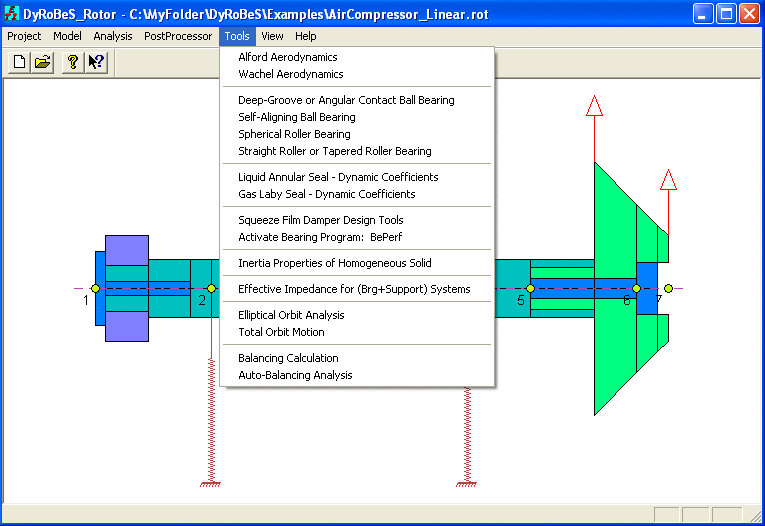
A number of engineering tools are included in the program for your convenience. To activate each tool, select the desirable tool from the main Tools menu.
The Alford and Wachel formulations are provided for the aerodynamic cross-coupling calculation. It calculates the cross-coupled stiffness coefficient and it can be a major source of destabilizing force in the turbomachinery.
A simple way to estimate the bearing deflection and stiffness for the rolling element bearings is also provided. The approximate stiffness can be used for the preliminary design study where high accuracy is not required.
The flow rate and dynamic coefficients of liquid annular seal and gas laby seal are also included. Two models are implemented in the liquid seal calculation: Black and Childs models. This effect is also known as Lomakin effect. The gas laby seal tool is provided by the courtesy of Dr. R. G. Kirk of Virginia Tech.
Another design tool is for the squeeze film damper design. It calculates the stiffness and damping for a give damper geometry and operation conditions. It is used for the preliminary design of the squeeze film damper. The complete rotor analysis is required for understanding the effect of the squeeze film damper in the system.
The Mass/Inertia properties calculation for a homogeneous cylinder or cone is also provided for easy reference.
A tool is provided to reduce the 4 DOF journal-bearing-support system to an equivalent 2 DOF journal-bearing system with the reduced equivalent bearing-support dynamic coefficients. Normally, the shaft rotational speed is selected to be the reduction frequency. Thus, the reduced bearing coefficients are called the synchronously reduced coefficients. DyRoBeS-Rotor is capable of handling the flexible supports, therefore, this reduction is not recommended. This reduction procedure is commonly used to demonstrate the effects of the flexible support. However, it is not advisable to perform this reduction in the analysis of complete rotor-bearing systems due to the single harmonic motion assumptions.
Rotor elliptical orbit analysis tool is provided for easy visualization of the rotor precessional motion and it provides some basic understandings of the rotor forward and backward motion. Total orbit motion can also be used to visualize the total rotor motion with various harmonic motions.
Balancing calculation is a tool that is based on the least square method (Influence coefficients method). It performs the balancing calculation to identify the balancing corrections without any knowledge in the rotor system. Auto-Balancing Analysis is another tool for balancing calculation. It assumes the rotor model is known and synchronous excitations are identified. However, the correction planes may not be in the right places. This auto-balancing program can help you to find the optimal corrections to minimize the rotor response due to synchronous excitations.
You may also activate the fluid film bearings program BePerf from the rotor program under tools menu.
Liquid Annular Seal Dynamic Coefficients
Gas Laby Seal Dynamic Coefficients
Squeeze Film Damper Design Tool
Mass/Inertia Properties Calculation
Reduction of Flexible Supports
Rotor Elliptical and Total Orbit Analysis

Copyright © 2014-2017